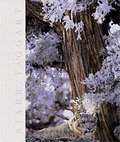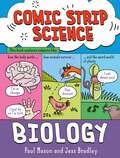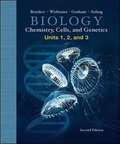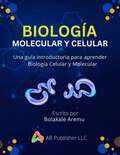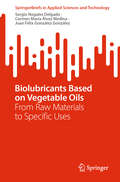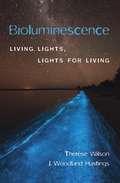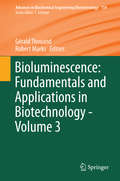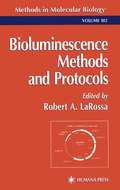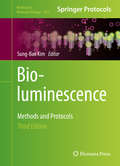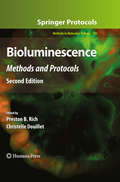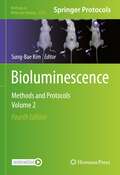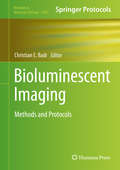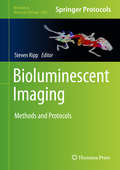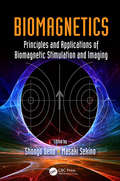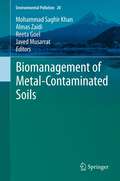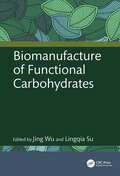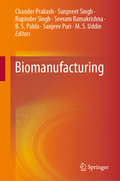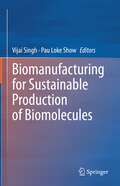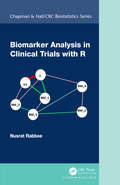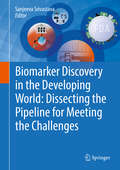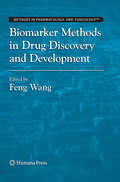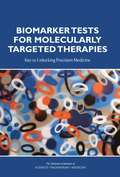- Table View
- List View
Biology: The Unity and Diversity of Life (9th edition)
by Cecie Starr Lisa Starr Ralph TaggartThe 9th edition of this undergraduate text seeks to make students aware of the connection between molecular change, evolution, and students' own lives. To achieve this goal, the text features essays on current controversial issues, links to concepts within and between chapters, two-page concept spreads, and problem solving examples and experiments that encourage students to think critically. Other changes include reorganized and rewritten material on areas such as energy flow and stem cell research. Author information is not given.
Biology: The science of animals, plants and the human body (Comic Strip Science #1)
by Paul MasonComic Strip Biology makes learning about the science behind animals, plants and the human body fun! Each spread in this series features a short, funny comic strip that explains a process or aspect of science. Around the comic strip, diagrams and panels give further information on the topic. They are a fantastic way to engage children aged 8 plus with science.The illustrator, Jess Bradey, is winner of the 2021 Blue Peter Award for Best Non-Fiction for A Day in the Life of a Poo, Gnu and You and also writes and draws for The Phoenix Comic. Titles in the series: Biology, Chemistry, Earth and Space, Physics.
Biology: Today and Tomorrow With Physiology
by Cecie Starr Lisa Starr Christine A. EversThe Sixth Edition of BIOLOGY TODAY AND TOMORROW WITH PHYSIOLOGY helps students build critical-thinking skills they will use as responsible, science-literate citizens. Packed with beautiful art and current applications, the book’s straightforward writing style and chunked content help students grasp the fundamentals of biology without overwhelming them with detail. Content updates reflect current research, new technology and the social implications of both, while active learning tools are woven into the narrative and art. This edition works seamlessly with MindTap, featuring Critical Thinking Cases, In-Class Active Learning Resources and Assessable Visualizations. A team of active instructors and subject-matter experts have further strengthened this edition's digital resources with more relevance, engagement and interactive learning opportunities.
Biology: Units 1,2, and 3
by Eric P. Widmaier Robert J. Brooker Linda Graham Peter StilingThis Volume of Biology covers Chemistry, Cell Biology, and Genetics. The Brooker et. al text features an evolutionary focus with an emphasis on scientific inquiry.
Biología Molecular y Celular: Una guía introductiva para aprender biología celular y molecular
by Bolakale AremuEste libro está diseñado para estudiantes que quieran aprender y apreciar temas biológicos básicos mientras estudian las menores unidades de la biología: moléculas y células. La biología celular y molecular es una disciplina dinámica. Hay miles de oportunidades en los campos médicos, farmacéuticos, agricultores, e industriales. Además de prepararte para una diversidad de trayectorias profesionales, entender la biología molecular y celular te ayudará a tomar buenas decisiones que pueden beneficiar tu dieta y salud.
Biolubricants Based on Vegetable Oils: From Raw Materials to Specific Uses (SpringerBriefs in Applied Sciences and Technology)
by Sergio Nogales Delgado Carmen María Álvez Medina Juan Félix González GonzálezThis is a book about biolubricants. It provides a general overview of these useful products, paying attention to their contribution to green and sustainable chemistry or the circular economy through the implementation of biorefineries. But also, it is a book about General Chemistry, Physics, Engineering, etc., as this specific subject could act as a cornerstone for many multidisciplinary fields. The book’s chapters include several exercises and questions to track reader’s learning and give general and specific idea of how biolubricants are not just a promising research topic, but also a practical reality. The main ideas covered in this work are the following: history, origin and use of biolubricants, main chemical routes to produce them and their quality assessment.
Bioluminescence
by Therese Wilson J. Woodland HastingsBioluminescence is everywhere on earth-most of all in the ocean, from angler fish in the depths to the flashing of dinoflagellates at the surface. Here, Thérèse Wilson and Woody Hastings explore the natural history, evolution, and biochemistry of the diverse array of organisms that emit light. While some bacteria, mushrooms, and invertebrates, as well as fish, are bioluminescent, other vertebrates and plants are not. The sporadic distribution and paucity of luminous forms calls for explanation, as does the fact that unrelated groups evolved completely different biochemical pathways to luminescence. The authors explore the hypothesis that many different luciferase systems arose in the early evolution of life because of their ability to remove oxygen, which was toxic to life when it first appeared on earth. As oxygen became abundant and bioluminescence was no longer adequate for oxygen removal, other antioxidant mechanisms evolved and most luminous species became extinct. Those light-emitting species that avoided extinction evolved uses with survival value for the light itself. Today’s luminous organisms use bioluminescence for defense from predators, for their own predatory purposes, or for communication in sexual courtship. Bioluminescence was earlier viewed as a fascinating feature of the living world, but one whose study seemed unlikely to contribute in any practical way. Today, bioluminescence is no longer an esoteric area of research. Applications are numerous, ranging from the rapid detection of microbial contamination in beef and water, to finding the location of cancer cells, to working out circuitry in the brain.
Bioluminescence: Fundamentals and Applications in Biotechnology - Volume 2 (Advances in Biochemical Engineering/Biotechnology #154)
by Gérald Thouand Robert MarksThis book review series presents current trends in modern biotechnology. The aim is to cover all aspects of this interdisciplinary technology where knowledge, methods and expertise are required from chemistry, biochemistry, microbiology, genetics, chemical engineering and computer science. Volumes are organized topically and provide a comprehensive discussion of developments in the respective field over the past 3-5 years. The series also discusses new discoveries and applications. Special volumes are dedicated to selected topics which focus on new biotechnological products and new processes for their synthesis and purification. In general, special volumes are edited by well-known guest editors. The series editor and publisher will however always be pleased to receive suggestions and supplementary information. Manuscripts are accepted in English.
Bioluminescence: Methods And Protocols (Methods in Molecular Biology #102)
by Robert A. LarossaA state-of-the-art collection of innovative methods for the use of luciferase and green fluorescent protein in analytical biochemistry, molecular toxicology, environmental monitoring, and cell-based assays. The contributors-all hands-on researchers who have perfected their protocols to a high degree of reproducibility-illustrate these powerful methods with a wide variety of applications ranging from the analytical determination (titer) of specific molecules to the cellular detection of a wide range of pollutants, to microbiological detection and analysis, and the molecular biological manipulation of lux, luc, and gfp structural genes. Step-by-step methods are also included for the construction of other recombinant organisms.
Bioluminescence: Methods and Protocols (Methods in Molecular Biology #1461)
by Sung Bae KimThis volume presents detailed laboratory protocols regarding the three major route technologies luciferases, efficient optical probes, and applications to visualizing molecular events in living subjects. "Bioluminescence: Methods and Protocols, Third Edition" guides readers through chapters on ingredients of bioluminescent probes, and fabrication of bioluminescent probes, applications to living subjects and instrumentations. Written in the highly successful "Methods in Molecular Biology "series format, chapters include introductions to their respective topics, lists of the necessary materials and reagents, step-by-step, readily reproducible laboratory protocols, and tips on troubleshooting and avoiding known pitfalls. Authoritative and practical, "Bioluminescence: Methods and Protocols, Third Edition" is a useful complement to the first and second edition for new and experienced researchers alike.
Bioluminescence: Methods and Protocols (Methods in Molecular Biology #574)
by Christelle Douillet Preston B. RichThrough the study and application of bioluminescence, scientists have painstakingly harnessed a powerful tool that enables us to seek a deeper understanding of the complex mechanisms underpinning so many vital biologic systems. In this fully revised and updated second edition of Bioluminescence: Methods and Protocols, expert researchers contribute a readable and utilitarian compilation of the newest and most innovative techniques that have emerged in this rapidly expanding and progressively diverse field including methods to assess cell trafficking, protein-protein interactions, intracellular signaling, and apoptosis. Also opening up the possibility to visualize and quantify biological mechanisms in real-time and in in vivo settings, the volume also describes the in vivo study of bacterial or viral infections, transplanted cells, stem cells proliferation, vascular flow, and tumors. Written in the highly successful Methods in Molecular BiologyTM series format, chapters include brief introductions to their respective topics, lists of the necessary materials, equipment, and reagents, step-by-step, readily reproducible laboratory protocols, and notes on troubleshooting and avoiding known pitfalls. Authoritative and cutting-edge, Bioluminescence: Methods and Protocols, Second Edition provides protocols that are detailed enough to be followed and adapted by scientific teams who have no previous expertise in bioluminescence in order to foster the potentially numerous breakthroughs and new applications from basic to applied science and medicine that must continue to be developed.
Bioluminescence: Methods and Protocols, Volume 1 (Methods in Molecular Biology #2524)
by Sung-Bae KimThis detailed collection explores recent advances in molecular imaging techniques involving bioluminescence, currently employed in biolaboratories around the world. Volume 1 delves into techniques for the establishment of luciferins and luciferases, basic in vitro and in vivo applications, as well as protocols on multiplex imaging platforms. Written for the highly successful Methods in Molecular Biology series, chapters include introductions to their respective topics, lists of the necessary materials and reagents, step-by-step, readily reproducible laboratory protocols, and tips on troubleshooting and avoiding known pitfalls. Authoritative and comprehensive, Bioluminescence: Methods and Protocols, Fourth Edition, Volume 1 presents practical guidance for researchers and technical staff on how to proceed with bioluminescence studies in their laboratories.
Bioluminescence: Methods and Protocols, Volume 2 (Methods in Molecular Biology #2525)
by Sung-Bae KimThis detailed collection explores recent advances in molecular imaging techniques involving bioluminescence, currently employed in biolaboratories around the world. Volume 2 delves into techniques for heterogeneous conjugates, protein fragment-complementation assays, BRET-based imaging, as well as instrumentation and software. Written for the highly successful Methods in Molecular Biology series, chapters include introductions to their respective topics, lists of the necessary materials and reagents, step-by-step, readily reproducible laboratory protocols, and tips on troubleshooting and avoiding known pitfalls. Authoritative and comprehensive, Bioluminescence: Methods and Protocols, Fourth Edition, Volume 2 presents practical guidance for researchers and technical staff on how to proceed with bioluminescence studies in their laboratories.
Bioluminescent Imaging: Methods and Protocols (Methods in Molecular Biology #1098)
by Christian E. Badr"Bioluminescent Imaging: Methods and Protocols" distills a wide range of techniques that use bioluminescence imaging as a tool for visualizing and tracking various biological processes. Covering diverse fields such as cellular and molecular biology, oncology, neurology, infectious diseases, immunology, and others, the detailed chapters of this volume are arranged by topic and describe practical procedures and applications of different bioluminescent reporters, from photoproteins (Aequorin) to bacterial luciferases as well as other secreted (such as Gaussia) and non-secreted luciferases (such as Firefly). Written in the highly successful "Methods in Molecular Biology" series format, chapters include introductions to their respective topics, lists of the necessary materials and reagents, step-by-step, readily reproducible laboratory protocols, and expert tips for troubleshooting and avoiding known pitfalls. Authoritative and cutting-edge, "Bioluminescent Imaging: Methods and Protocols" aims to provide diverse and comprehensive techniques to researchers interested in implementing bioluminescence-based imaging in their laboratory, regardless of their previous level of experience with such methodologies.
Bioluminescent Imaging: Methods and Protocols (Methods in Molecular Biology #2081)
by Steven RippThis volume provides detailed protocols and methodologies required to perform bioluminescent imaging in multiple stages, enabling the reader to integrate this technology into their laboratory-based imaging experiments. Written in the highly successful Methods in Molecular Biology series format, chapters include introductions to their respective topics, lists of the necessary materials and reagents, step-by-step, readily reproducible laboratory protocols, and tips on troubleshooting and avoiding known pitfalls. Authoritative and cutting-edge, Bioluminescent Imaging: Methods and Protocols to ensure successful results in the further study of this vital field.
Biomagnetics: Principles and Applications of Biomagnetic Stimulation and Imaging
by Trevor R. HodkinsonDiscover the Most Advanced Technologies in BiomagneticsCo-edited by Professor Ueno, a leader in the biomagnetics field for over 40 years, Biomagnetics: Principles and Applications of Biomagnetic Stimulation and Imaging explains the physical principles of biomagnetic stimulation and imaging and explores applications of the latest techniques in neuroscience, clinical medicine, and healthcare. The book shows you how the techniques are used in hospitals and why they are so promising. A brief overview of recent research trends in biomagnetics provides you with an up-to-date, informative guide to explore further in this field.The book focuses on three important areas: Magnetic nerve stimulation and transcranial magnetic stimulation Biomagnetic measurements and imaging of the human brain by advanced technologies of magnetoencephalography and MRI Biomagnetic approaches to potential treatments of cancers, pains, and other neurological and psychiatric diseases, such as Alzheimer’s disease and depression These core areas of the book were developed from the editors’ prestigious graduate-level courses in biomedical engineering. The text also discusses biomagnetic approaches to advanced medicine, including regenerative and rehabilitation medicine.
Biomanagement of Metal-Contaminated Soils (Environmental Pollution #20)
by Javed Musarrat Almas Zaidi Mohammad Saghir Khan Reeta GoelHeavy-metal contamination is one of the world's major environmental problems, posing significant risks to agro-ecosystems. Conventional technologies employed for heavy-metal remediation have often been expensive and disruptive. This book provides comprehensive, state-of-the-art coverage of the natural, sustainable alternatives that use a wide range of biological materials in the removal/detoxification of heavy metals, consequently leading to the improvement of crops in these soils. Novel, environmentally friendly and inexpensive solutions are presented based on a sound understanding of metal contamination and the roles of plants and microbes in the management of these toxic soils. Written by worldwide experts, the book provides not only the necessary scientific background but also addresses the challenging questions that require special attention in order to better understand metal toxicity in soils and its management through bioremediation.
Biomanufacture of Functional Carbohydrates
by Jing Wu and Lingqia SuFunctional carbohydrates have low or moderate energy and health-promoting effects. They are greatly favored in a variety of areas, such as food, pharmaceuticals, feed, and agriculture. The low-cost and high-yield manufacturing of functional carbohydrates is a prerequisite for their widespread application. Compared to extraction and chemical methods, biomanufacture dominates the production of functional carbohydrates, and there have been continuous innovations and technological progress over the last decades.Biomanufacture of Functional Carbohydrates provides the systemic introduction of biomanufacture of ten functional carbohydrates. Each chapter introduces the function and application of a functional carbohydrate, and then focuses on the recent advancements of the enzymes and catalytic pathways associated with its biosynthesis. It provides detailed information on the structure and function, molecular modification, and preparation of the relative enzymes and the strategies of preparation of the functional carbohydrates catalyzed by single or complex enzymes and discusses the characteristics of different strategies. The microbial fermentation methods for producing some functional carbohydrates, including details about construction and regulation of recombinant strains, are also described. In addition, this book provides suggestions for future research in the biomanufacture of functional carbohydrates.Features: Presents detailed information of enzymes used for preparation of the functional carbohydrates Focuses on the structure and function, molecular modification, and preparation of the relative enzymes Introduces strategies of preparation of the functional carbohydrates catalyzed by single or complex enzymes Compares the characteristics of different strategies Readers will gain timely and comprehensive knowledge of the emerging science and technology around biomanufacture of functional carbohydrates and how to select, acquire, and use the appropriate enzymes to produce functional carbohydrates and advance the benefits of human life.
Biomanufacturing
by Seeram Ramakrishna Rupinder Singh Chander Prakash Sunpreet Singh B. S. Pabla Sanjeev Puri M. S. UddinCurrent Trends in Biomanufacturing focuses on cutting-edge research regarding the design, fabrication, assembly, and measurement of bio-elements into structures, devices, and systems.The field of biomaterial and biomanufacturing is growing exponentially in order to meet the increasing demands of for artificial joints, organs and bone-fixation devices. Rapid advances in the biological sciences and engineering are leading to newer and viable resources, methods and techniques that may providing better quality of life and more affordable health care services.The book covers the broad aspects of biomanufacturing, including:synthesis of biomaterials;implant coating techniques;spark plasma sintering;microwave processing; andcladding, powder metallurgy and electrospinning.The contributors illustrate the recent trends of biomanufacturing, highlighting the important aspects of biomaterial synthesis, and their use as feedstock of fabrication technologies and their characterization, along with their clinical practices. Current Trends in Biomanufacturing updates researchers and scientists the novelties and techniques of the field, as it summarises numerous aspects of biomanufacturing, including synthesis of biomaterials, fabrication of biomedical structures, their in-vivo/ in-vitro, mechanical analysis and associated ISO standards.
Biomanufacturing for Sustainable Production of Biomolecules
by Pau Loke Show Vijai SinghThis book elucidates the sustainable production of commercially important biomolecules in medicines, food, and beverage processing, through biological systems, including microorganisms, animal cells, plant cells, tissues, enzymes, and in vitro. It discusses promising technologies for the manipulation of cells including, genetic engineering, synthetic biology, genome editing, and metabolic engineering. The initial chapters of the book introduce topics on biomanufacturing, circular economy, strain design and improvement, upstream and downstream processing. The subsequent chapters cover artificial intelligence-assisted production, designer cell factories, biosensors for monitoring biomolecules, different cells factories, biosynthetic pathways, and genome editing approaches for scale-up biomanufacturing. Lastly, the book discusses the opportunities and challenges of implementing biological systems for the production of biomolecules. This book is a valuable source for students, researchers, scientists, clinicians, stakeholders, policymakers, and practitioners to understand biomanufacturing for the sustainable production of biomolecules.
Biomarker Analysis in Clinical Trials with R (Chapman & Hall/CRC Biostatistics Series)
by Nusrat RabbeeThe world is awash in data. This volume of data will continue to increase. In the pharmaceutical industry, much of this data explosion has happened around biomarker data. Great statisticians are needed to derive understanding from these data. This book will guide you as you begin the journey into communicating, understanding and synthesizing biomarker data. -From the Foreword, Jared Christensen, Vice President, Biostatistics Early Clinical Development, Pfizer, Inc. Biomarker Analysis in Clinical Trials with R offers practical guidance to statisticians in the pharmaceutical industry on how to incorporate biomarker data analysis in clinical trial studies. The book discusses the appropriate statistical methods for evaluating pharmacodynamic, predictive and surrogate biomarkers for delivering increased value in the drug development process. The topic of combining multiple biomarkers to predict drug response using machine learning is covered. Featuring copious reproducible code and examples in R, the book helps students, researchers and biostatisticians get started in tackling the hard problems of designing and analyzing trials with biomarkers. Features: Analysis of pharmacodynamic biomarkers for lending evidence target modulation. Design and analysis of trials with a predictive biomarker. Framework for analyzing surrogate biomarkers. Methods for combining multiple biomarkers to predict treatment response. Offers a biomarker statistical analysis plan. R code, data and models are given for each part: including regression models for survival and longitudinal data, as well as statistical learning models, such as graphical models and penalized regression models. Nusrat Rabbee is a biostatistician and data scientist at Rabbee & Associates, where she creates innovative solutions to help companies accelerate drug and diagnostic development for patients. Her research interest lies in the intersection of data science and personalized medicine. She has extensive experience in bioinformatics, clinical statistics and high-dimensional data analyses. She has co-discovered the RLMM algorithm for genotyping Affymetrix SNP chips and co-invented a high-dimensional molecular signature for cancer. She has spent over 17 years in the pharmaceutical and diagnostics industry focusing on biomarker development. She has taught statistics at UC Berkeley for 4 years.
Biomarker Discovery in the Developing World: Dissecting the Pipeline for Meeting the Challenges
by Sanjeeva SrivastavaThis book is oriented towards post-graduates and researchers with interest in proteomics and its applications in clinical biomarker discovery pipeline. Biomarker discovery has long been the research focus of many life scientists globally. However, the pipeline starting from discovery to validation to regulation as a diagnostic or therapeutic molecule follows a complex trajectory. This book aims to provide an in-depth synopsis on each of these developmental phases attendant to biomarker "life cycle" with emphasis on the emerging and significant role of proteomics. The book begins with a perspective on the role of biorepositories and need for biobanking practices in the developing world. The next chapter focuses on disease heterogeneity in context to geographical bias towards susceptibility to the disease and the role of multi-omics techniques to devise disruptive innovations towards biomarker discovery. Chapter 3 focuses on various omics-based platforms that are currently being used for biomarker discovery, their principles and workflow. Mass spectrometry is emerging as a powerful technology for discovery based studies and targeted validation. Chapter 4 aims at providing a glimpse of the basic workflow and considerations in mass spectrometry based studies. Rapid and aptly targeted research funding has often been deemed as one of the decisive factors enabling excellent science and path breaking innovations. With the need for sophistication required in multi-omics research, Chapter 5 focuses on innovative funding strategies such as crowdfunding and Angel philanthropy. Chapter 6 provides the latest advances in education innovation, the premise and reality of bioeconomy especially in a specific context of the developing world, not to mention the new concept of "social innovation" to link biomarkers with socially responsible and sustainable applications. Chapter 7, in ways similar to biomarkers, discusses the biosimilars as a field that has received much focus and prominence recently due to their immense potential in clinical and pharmaceutical innovation literatures. The broader goal post-biomarker discovery is to translate their use in clinics. However, the road from bench-to-bed side is arduous and complex that is subject to oversight from various national and international regulatory bodies. Chapter 8 underscores these regulatory science considerations and provides a concise overview on intellectual property rights in biomarker discovery. Thus, this book contributed by eminent biomarker scientists, clinicians, translational researchers and social scientists holistically covers the various facets of the biomarker discovery journey from "cell to society" in developing world. The lessons learned and highlighted here are of interest to the life sciences community in a global and interdependent world.
Biomarker Methods in Drug Discovery and Development (Methods in Pharmacology and Toxicology)
by Feng WangIn this book, expert researchers provide a tool box for those who have a general interest in biomarker research and for those currently specializing in certain technologies but desiring an understanding of other available methodologies. Its chapters include validated, mature methods as well as new, incredibly promising protocols. This book is the perfect biomarker technical guideline and reference to stimulate more exciting biomarker research and technology development.
Biomarker Tests for Molecularly Targeted Therapies: Key to Unlocking Precision Medicine
by Engineering Medicine National Academies of SciencesEvery patient is unique, and the evolving field of precision medicine aims to ensure the delivery of the right treatment to the right patient at the right time. In an era of rapid advances in biomedicine and enhanced understanding of the genetic basis of disease, health care providers increasingly have access to advanced technologies that may identify molecular variations specific to an individual patient, which subsequently can be targeted for treatment. Known as biomarker tests for molecularly targeted therapies, these complex tests have the potential to enable the selection of the most beneficial treatment (and also to identify treatments that may be harmful or ineffective) for the molecular underpinnings of an individual patient’s disease. Such tests are key to unlocking the promise of precision medicine. Biomarker tests for molecularly targeted therapies represent a crucial area of focus for developing methods that could later be applicable to other areas of precision medicine. The appropriate regulatory oversight of these tests is required to ensure that they are accurate, reliable, properly validated, and appropriately implemented in clinical practice. Moreover, common evidentiary standards for assessing the beneficial impact of biomarker-guided therapy selection on patient outcomes, as well as the effective collection and sharing of information related to those outcomes, are urgently needed to better inform clinical decision making. Biomarker Tests of Molecularly Targeted Therapies examines opportunities for and challenges to the use of biomarker tests to select optimal therapy and offers recommendations to accelerate progress in this field. This report explores regulatory issues, reimbursement issues, and clinical practice issues related to the clinical development and use of biomarker tests for targeting therapies to patients. Properly validated, appropriately implemented biomarker tests hold the potential to enhance patient care and improve outcomes, and therefore addressing the challenges facing such tests is critical.
